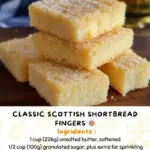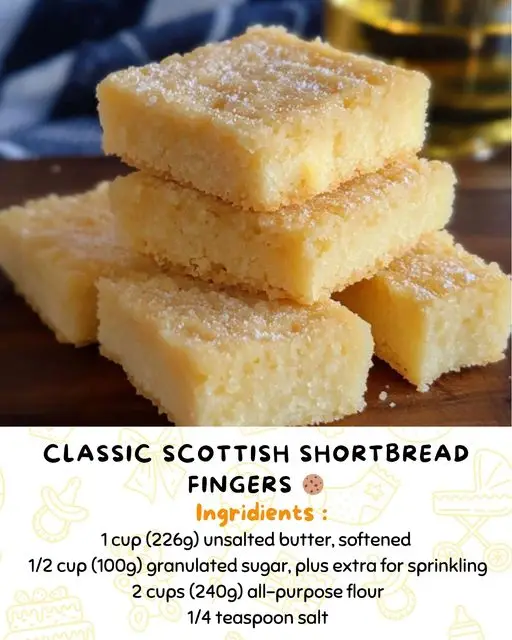Introduction
Classic Scottish shortbread fingers are a beloved treat, known for their rich buttery taste and crumbly texture. Originating from Scotland, this simple yet delicious biscuit has become a staple across the globe. In this article, you’ll learn the history, the perfect recipe, and tips to make authentic shortbread fingers.
The History of Scottish Shortbread
Scottish shortbread dates back to medieval Scotland, originally a type of “biscuit bread” made from leftover bread dough. Over time, butter replaced yeast, and the modern shortbread was born. The classic three-ingredient recipe—flour, butter, and sugar—was perfected in the 18th century and became synonymous with Scottish hospitality.
Shortbread is closely associated with Hogmanay (Scottish New Year), where it’s traditionally given as a gift to welcome the new year. The “fingers” shape is one of the most popular variations, ideal for dunking in tea or coffee.
The Perfect Classic Scottish Shortbread Fingers Recipe
Ingredients
- 1 cup (226g) unsalted butter, softened
- 1/2 cup (100g) granulated sugar, plus extra for sprinkling
- 2 cups (240g) all-purpose flour
- 1/4 teaspoon salt
Instructions
- Prepare the Dough:
- Preheat your oven to 300°F (150°C). Lightly grease an 8×8-inch (20×20 cm) baking pan or line it with parchment paper.
- In a large mixing bowl, cream the softened butter and sugar together until light and fluffy.
- Gradually add the flour and salt to the butter mixture, mixing until a soft dough forms. Be careful not to overmix.
- Shape and Bake:
- Press the dough evenly into the prepared baking pan, smoothing the top with the back of a spoon.
- Use a fork to prick the dough all over; this helps the shortbread bake evenly.
- Sprinkle a little extra sugar over the top for a nice crunch.
- Bake for 45-50 minutes, or until the shortbread is pale golden in color (avoid browning it too much, as it should be light in color).
- Cut and Serve:
- Remove the shortbread from the oven and let it cool for about 10 minutes.
- While still warm, cut the shortbread into fingers or squares. Allow it to cool completely in the pan before removing the pieces.
Tips for Perfect Shortbread
- Use high-quality butter for the best flavor.
- Don’t skip chilling the dough, as it prevents spreading.
- Cut the fingers before baking to achieve clean, sharp edges.
- For variations, consider adding a pinch of vanilla or lemon zest.
Serving Suggestions
Classic shortbread fingers pair beautifully with a cup of tea or coffee. For a festive twist, dip one end in melted chocolate or sprinkle with a hint of cinnamon sugar.
Why Shortbread is an SEO-Friendly Topic
The popularity of Scottish shortbread fingers lies in their simplicity and tradition. Keywords like “classic Scottish shortbread,” “easy shortbread recipe,” and “buttery biscuits” are frequently searched by baking enthusiasts. Crafting content around these terms helps attract readers looking for traditional recipes or baking inspiration.
Conclusion
Classic Scottish shortbread fingers are more than just a biscuit—they’re a taste of tradition. With only a few ingredients and simple steps, you can recreate this iconic treat at home. Whether for a festive celebration or a quiet tea time, these buttery delights are sure to impress.

